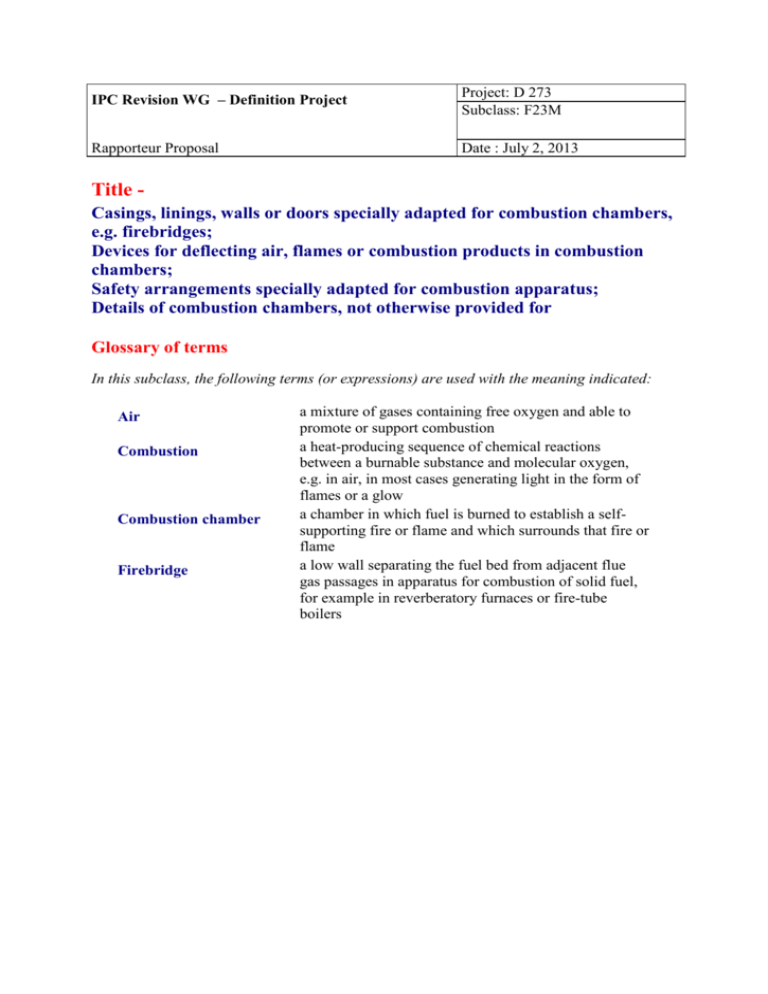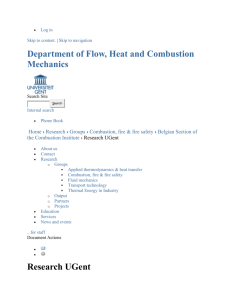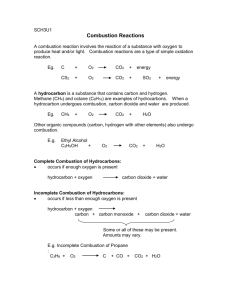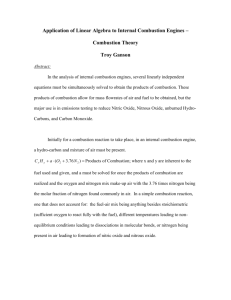References relevant to classification in this subclass
advertisement

IPC Revision WG – Definition Project Project: D 273 Subclass: F23M Rapporteur Proposal Date : July 2, 2013 Title Casings, linings, walls or doors specially adapted for combustion chambers, e.g. firebridges; Devices for deflecting air, flames or combustion products in combustion chambers; Safety arrangements specially adapted for combustion apparatus; Details of combustion chambers, not otherwise provided for Glossary of terms In this subclass, the following terms (or expressions) are used with the meaning indicated: Air Combustion Combustion chamber Firebridge a mixture of gases containing free oxygen and able to promote or support combustion a heat-producing sequence of chemical reactions between a burnable substance and molecular oxygen, e.g. in air, in most cases generating light in the form of flames or a glow a chamber in which fuel is burned to establish a selfsupporting fire or flame and which surrounds that fire or flame a low wall separating the fuel bed from adjacent flue gas passages in apparatus for combustion of solid fuel, for example in reverberatory furnaces or fire-tube boilers IPC Revision WG – Definition Project Project: D 273 Subclass: F23M 5/00 Rapporteur Proposal Date : July 2, 2013 Title Casings; Linings; Walls Relationship between large subject matter areas Combustion apparatus: This group is a detail place in relation to subclasses F23B, F23C, F23G and F23R, which cover complete apparatus. Arrangements that affect the overall design of a combustion apparatus should be classified in those subclasses. Application places for combustion apparatus: Some wall constructions should be considered as special adaptations to special types of combustion apparatus and therefore classified in the places for these types. Examples of such places can be found under the heading "References relevant to classification in this subclass" below. Places for construction in general: This group covers special adaptations of casings, linings or walls for specific requirements of combustion chambers, for example relating to resistance to heat or flames, heat insulation or adaptation to the layout or function of a combustion chamber. Features that are of interest for general construction purposes should be classified in general places for building or construction. Examples of such places can be found under the heading "Informative references" below. References relevant to classification in this subclass This subclass does not cover: Construction or support of tube walls for steam boilers F22B Examples of places where the subject matter of this class is covered when specially adapted, used for a particular purpose, or incorporated in a larger system: Preventing corrosion in apparatus specially adapted for combustion of waste or low-grade fuels, e.g. incinerators F23G 5/44 Film cooling arrangements for gas turbine combustion chambers F23R 3/00 Construction of tiles or bracing means therefor for domestic masonry stoves for solid fuels F24B 1/06 Casings for domestic stoves or ranges F24C 15/08 Casings for water heaters, e.g. heating boilers F24H 9/02 Casings, linings, wall or roofs of furnaces, kilns, ovens or retorts F27B, F27D 1/00 Informative references Attention is drawn to the following places, which may be of interest for search: General building constructions, e.g. walls, roofs or insulation of buildings E04B Structural elements or building materials, e.g. bricks E04C IPC Revision WG – Definition Project Project: D 273 Subclass: F23M 7/00 Rapporteur Proposal Date : July 2, 2013 Title Doors Relationship between large subject matter areas Combustion apparatus: This group is a detail place in relation to subclasses F23B, F23C and F23G, which cover complete apparatus. Arrangements that affect the overall design of a combustion apparatus should be classified in those subclasses. Application places for combustion apparatus: Some door constructions should be considered as special adaptations to special types of combustion apparatus and therefore classified in the places for these types. Examples of such places can be found under the heading "References relevant to classification in this subclass" below. Places for construction in general: This group covers special adaptations of doors for specific requirements of combustion chambers, for example relating to resistance to heat or flames, heat insulation or installation of burners or other combustion equipment. Features that are of interest for general construction purposes should be classified in general places for building or construction. Examples of such places can be found under the heading "Informative references" below. References relevant to classification in this subclass Examples of places where the subject matter of this class is covered when specially adapted, used for a particular purpose, or incorporated in a larger system: Doors for open fires for solid fuels F24B 1/192 Doors specially adapted for domestic stoves or ranges F24C 15/02 Doors for furnaces, kilns, ovens or retorts F27D 1/18 Informative references Attention is drawn to the following places, which may be of interest for search: Bolts or fastening devices for doors E05C Hinges or other suspension devices for doors E05D Operating mechanisms for doors E05F Doors in general E06B IPC Revision WG – Definition Project Project: D 273 Subclass: F23M 9/00 Rapporteur Proposal Date : July 2, 2013 Title Baffles or deflectors for air or combustion products; Flame shields Relationship between large subject matter areas Combustion apparatus: This group is a detail place in relation to subclasses F23B, F23C, F23G and F23R, which cover complete apparatus. Arrangements that affect the overall design of a combustion chamber or the entire combustion process in the apparatus should be classified in those subclasses, for example in F23B 80/04, F23C 9/00 or F23R 3/16. Application places for combustion apparatus: Some baffles, deflectors or flame shields should be considered as special adaptations to special types of combustion apparatus and therefore classified in the places for these types. Examples of such places can be found under the heading "References relevant to classification in this subclass" below. References relevant to classification in this subclass This subclass does not cover: Baffles or deflectors for air or combustion products structurally associated with burners F23D, e.g. F23D 3/02, F23D 11/40, F23D 14/70 Examples of places where the subject matter of this class is covered when specially adapted, used for a particular purpose, or incorporated in a larger system: Steam boilers F22B Fluid heaters, e.g. heating boilers F24H Furnaces, kilns, ovens or retorts F27B IPC Revision WG – Definition Project Project: D 273 Subclass: F23M 11/00 Rapporteur Proposal Date : July 2, 2013 Title Safety arrangements Relationship between large subject matter areas Safety arrangements involving control of combustion: This group does not cover combustion control systems which maintain safe operating conditions during normal operation of combustion apparatus, for example by monitoring temperatures, or react by controlling combustion when undesired or dangerous condition are detected, for example shutting down the combustion when fuel or air supply is interrupted. Such control systems are covered by subclass F23N. Application places for combustion apparatus: Some safety arrangements should be considered as special adaptations to special types of combustion apparatus and therefore classified in the places for these types. Examples of such places can be found under the heading "References relevant to classification in this subclass" below. References relevant to classification in this subclass This subclass does not cover: Safety arrangements structurally associated with burners F23D, e.g. F23D 3/26, F23D 5/16, F23D 14/72 Safety devices for liquid fuel feeding F23K 5/16 Preventing development of abnormal or undesired conditions by controlling combustion F23N 5/24 Safety arrangements structurally associated with igniters F23Q, e.g. F23Q 7/24, F23Q 9/12 Examples of places where the subject matter of this class is covered when specially adapted, used for a particular purpose, or incorporated in a larger system: Applications, arrangements, or dispositions of automatic safety devices in steam boilers F22B 37/42 Safety arrangements in apparatus specially adapted for combustion of waste or low-grade fuels, e.g. incinerators F23G 5/50 Arrangement or mounting of safety devices in domestic stoves or ranges for gaseous fuels F24C 3/12 Arrangement or mounting of safety devices in domestic stoves or ranges for liquid fuels F24C 5/16 Arrangement or mounting of safety devices in fluid heaters, e.g. heating boilers F24H 9/20 Arrangement of safety devices in furnaces, kilns, ovens or retorts F27D 21/00 Informative references Attention is drawn to the following places, which may be of interest for search: Fire-fighting A62C Extinguishing devices F23Q 25/00 Fire alarms G08B 17/00 IPC Revision WG – Definition Project Project: D 273 Subclass: F23M 20/00 Rapporteur Proposal Date : July 2, 2013 Title Details of combustion chambers, not otherwise provided for Relationship between large subject matter areas This group is the residual group for details of combustion chambers. Therefore classification should only be made in this group if there is no other place in the IPC that covers the subject matter to be classified. A list of examples of other places covering details of combustion apparatus can be found under the heading "References relevant to classification in this subclass" below. References relevant to classification in this subclass Places in relation to which this subclass is residual: Details of steam boilers F22B, e.g. F22B 37/00 Mounting or disposition of burners F23C 5/00 Supplying air or non-combustible liquids or gases F23C 7/00, F23L Details of fluidised bed combustion apparatus F23C 10/18 Burners F23D Details specially adapted for apparatus for combustion of waste or low-grade fuels, e.g. incinerators F23G 5/44 Grates; Cleaning or raking grates F23H Removal or treatment of combustion products or combustion residues F23J Feeding fuel F23K Casings, linings, walls or doors F23M 3/00 – F23M 7/00 Devices for deflecting air, flames or combustion products F23M 9/00 Safety arrangements F23M 11/00 Ignition F23Q Details of stoves or ranges burning solid fuels F24B 1/191, F24B 13/00 Details of stoves or ranges burning fuels other than solid fuels F24C, e.g. F23C 15/00 Details of fluid heaters, e.g., heating boilers F24H 9/00 Details of furnaces, kilns, ovens or retorts F27B, F27D








